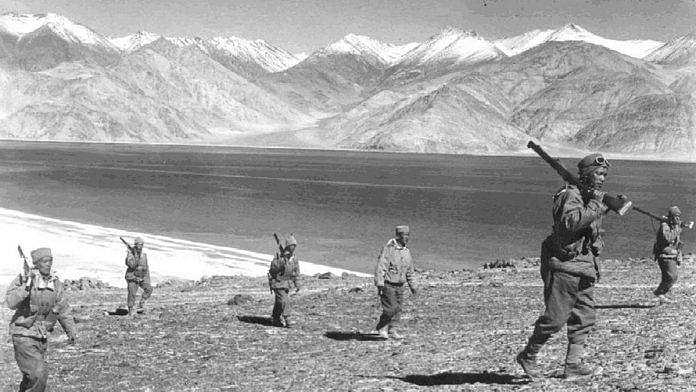New Delhi: India woke up to a nightmare at five in the morning of 20 October 1962. The onslaught started with two bright flares in the cold sky and ended with hundreds of Indian soldiers lying dead or wounded at Thagla Ridge across the flowing waters of the Namka Chu.
The night before, Chinese soldiers had cut all the telephone and other communication lines, so even calling for help was impossible.
But the carnage now known as the Battle of Namka Chu, and sometimes as India’s “day of reckoning” in the 1962 India-China war, had been building up for a while.
In the summer of that year, India had set into motion its plan of occupying the Thagla Ridge by setting up an outpost at Dhola in the Namka Chu gorge as part of its ill-fated Forward Policy — the name given to a directive to establish forward posts to reclaim territory from China.
While the treaty map of 1914 depicted the McMahon Line — the effective boundary between China and India— as lying south of the Thagla Ridge, scholar Srinath Raghavan explains in his book War and Peace in Modern India that during the buildup to the 1962 Sino-Indian war, India argued that the boundary lay on the ridge. As a consequence, India believed occupying the Thagla Ridge would be prudent.
The Chinese did not agree. From September to the middle of October 1962, a slew of skirmishes between the Indians and Chinese erupted in the Thagla region, across the Namkha Chu riverbank at Dhola, Tseng-Jong, and Tsangle.
These face-offs snowballed into a much bigger battle when Chinese infantrymen moved across the McMahon Line and set up four battalions south of the Thagla Ridge.
On 20 October, they began a merciless bombardment of the Indian positions, signalling the start of the Sino-Indian war. On the same day, notably, the Chinese army also swept into India on the western sector of the border, including the Galwan Valley.
Also read: From clash at Longju to ‘Operation Leghorn’, how skirmishes built up to 1962 India-China war
Chinese buildup at Thagla Ridge
Between 19 and 20 October 1962, the Chinese battalions occupied three specific positions across the Thagla Ridge region.
First, they took defensive positions on the riverbank of the Namka Chu, which flows near the Thagla Ridge. Then, they occupied the slopes and crest of the ridge, notes the official history of the 1962 war, published by India’s Ministry of Defence (MoD) in 1992-93.
By 20 October, the Chinese presence in the Thagla region had grown from four battalions to a full division.
Importantly, the official history adds, the Chinese had mobilised with all the weaponry they needed — heavy machine guns, mortars, and entrenching tools — to launch a major offensive against the Indian troops.
Bloody morning
At exactly 5 am, the Chinese opened heavy mortar fire on the Indian posts spread across the Namka Chu region. An hour later, they doubled down with heavy shelling at the Indian forces positioned at Dhola post and Tsangdhar Ridge, on the banks of the Namka Chu.
By 7 am, the Dhola post had been completely overrun by the Chinese. While most of the soldiers fighting at Dhola laid down their lives in battle, Major Gurdial Singh of 2 Rajput rallied his remaining troops and led a final charge at the Chinese.
Howevert, the enemy was at an advantage and very few of the Indian troops survived. Major Singh was taken as a prisoner of war. He would receive the Maha Vir Chakra, India’s second-highest military decoration, while still in captivity. Overall, 282 soldiers from the Rajput Regiment died defending Dhola, adds the official history.
Marching ahead, between 8 and 8:30 am, the Chinese surprised the Indians at Tsangdhar, attacking them via the flanks and taking the position shortly afterwards.
They also gave cover fire to their troops, assaulting the Indians across the Namka Chu, from positions taken at forward slopes of the Thagla Ridge, explains the official war history.
‘Withdrawal… was unavoidable’
As the carnage unfolded on 20 October, pockets of resistance from the Indians endured at Tsangdhar, the MoD’s war history claims.
“The Rajputs and Gorkhas deployed at these locations [Dhola & Tsangdhar] gave tough fight,” it says, but adds that they were “soon overpowered.”
Significantly, when the Chinese onslaught began across the Namka Chu, India’s lines of communication with the brigade headquarters had been destroyed.
Captain Ravi of 2 Rajput had to physically go and inform the brigade headquarters that his company had been wiped out at Dhola. Across battle points, many mortar and gun positions of the Indian units could not be contacted and engaged, as the Chinese had used jammers to block the radio frequencies the Indian forces were using, adds the official history.
By the the afternoon of 20 October, the Chinese had either destroyed Indian posts across the Namka Chu or driven them back. Finally, troops at Tsangdhar were also ordered to withdraw southwards to Lumpo on 20 October, adds the war history.
Half a day into battle, the Indians had lost so many men, especially in Dhola and Tsangdhar, that they had to withdraw across the Namka Chu region.
Essentially, three battalions of Indian troops had been given the responsibility to defend over 20 km of territory. This was untenable, given the long marching distances over the terrain. Further, the troops were hampered by a lack of adequate firepower, a dearth of personnel, poor logistics and supply lines, all of which significantly enhanced the challenge at hand.
Finally, the objective at Thagla was to not defend but attack and overthrow the Chinese from the region, an impractical goal given the stark asymmetries on display.
“The withdrawal of the Indian troops from the Dhola sector was unavoidable. They were acting under manifold handicaps,” the war history says.
(Edited by Asavari Singh)
Also read: A face-off in Galwan, 60 years ago: How border brinkmanship triggered 1962 India-China war



